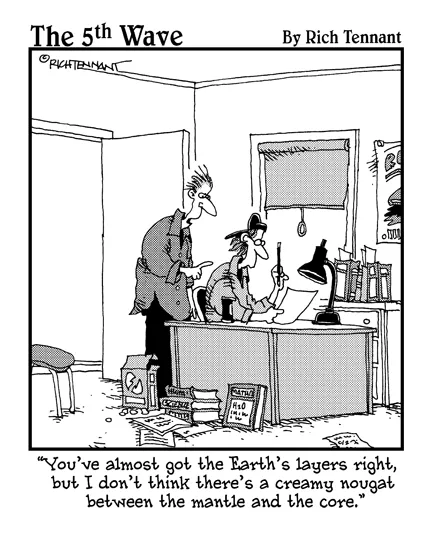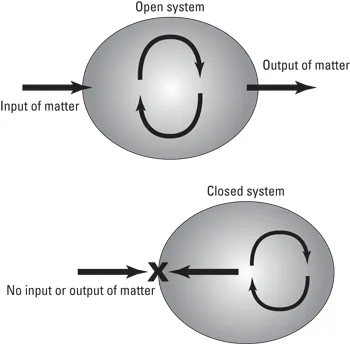Part I
Demystifying Science and the Environment
In this part . . .
At its core, environmental science is like any science — based on a methodical way of asking and answering questions to expand the human understanding of the natural world.
In this part, I describe how the scientific method shapes the process of learning about the environment. I also cover foundational scientific ideas about what makes up everything around you (atoms, molecules, and compounds) and how energy moves things through the environment. This is also where you find out how green plants capture energy from the sun and transform it into sugar through the process of photosynthesis.
Chapter 1
Investigating the Environment
In This Chapter
Applying a scientific approach
Studying environmental systems
Protecting natural resources
Reducing pollutants in the air and water
Looking forward to a sustainable future
In its simplest terms, environmental science is the study of the air you breathe, the water you drink, and the food you eat. But environmental scientists study so much of the natural world and the way humans interact with it that their studies spill over into many other fields. Whether you’re a student in a college course or someone who picked up this book to find out what environmental science is all about, you’ll find that the ideas in this book apply to your life.
Like any living creature, you depend on environmental resources. More importantly perhaps is the fact that humans, unlike other living creatures, have the ability to damage these resources with pollution and overuse. This chapter provides a quick overview of the environment, its systems, and its many resources. It also talks about what humans can do to reduce their impact on the environment today and into the future. After all, maintaining the health of the Earth and its resources at both the local and global level is something everyone has a stake in.
Putting the “Science” in Environmental Science
Environmental science draws on knowledge from many different fields of study, including the so-called hard sciences like chemistry, biology, and geology and the social sciences like economics, geography, and political science. This section offers a quick overview of some of the scientific concepts, such as how to apply the scientific method to answer questions, that you need to be familiar with as you start your exploration of environmental science. I explain these foundational scientific concepts in more detail throughout the rest of Part I.
Using the scientific method
The scientific method is simply a methodical approach to asking questions and collecting information to answer those questions. Although many classes teach it as something that only scientists use, you use it just about every day, too.
You may not write down each step of the scientific method when you use it, but anytime you ask a question and use your senses to answer it, you’re using the scientific method. For example, when standing at a crosswalk, you look both ways to determine whether a car is coming and whether an approaching car is going slow enough for you to safely cross the street before it arrives. In this example, you have made an observation, collected information, and based a decision on that information — just like a scientist!
The power of the scientific method is in the way scientists use it to organize questions and answers. It helps them keep track of what’s known and what’s unknown as they gather more knowledge. This organization becomes particularly important when they study large, complex systems like those found in the natural world. Scientists always have more to learn about the natural world, and using the scientific method is one way that they can follow the path of scientific investigation from one truth to another. Turn to Chapter 2 for more on the scientific method.
Understanding the connection between atoms, energy, and life
Studying the environment includes studying how matter, energy, and living things interact. This is where other fields of study, such as chemistry, physics, and biology, come into play. Here are just a few of the core ideas from these sciences that you need to understand as you study environmental science:
All matter is made of atoms.
Matter is never created or destroyed, but it does change form.
Living matter, or life, is made up of complex combinations of carbon, hydrogen, and oxygen atoms.
Most of the energy at Earth’s surface comes from the sun.
Energy transfers from one form to another.
Living things, or organisms, either capture the sun’s energy (through
photosynthesis) or get their energy by eating other living things.
Analyzing the Earth’s Physical Systems and Ecosystems
The environment consists of many different systems that interact with one another on various levels. Some systems are physical, such as the hydrologic system that transfers water between the atmosphere and the Earth’s surface. Other systems are built on interactions between living things, such as predator-prey relationships.
Scientists recognize that systems can be either open or closed. An open system allows matter and energy to enter and exit. A closed system keeps matter and energy inside of it. Figure 1-1 illustrates both types of systems.
Figure 1-1: Open and closed systems.
Illustration by Wiley, Composition Services Graphics
Very few systems in the natural world are truly closed systems. Scientists view the planet as a closed system in terms of matter (no matter enters or leaves the Earth), but they consider it an open system in terms of energy (energy enters the Earth from the sun). The following sections introduce you to a few of the Earth’s other systems that you need to be familiar with. (Part II goes into a lot more detail on the different systems on Earth.)
Sorting the world into climate categories...















